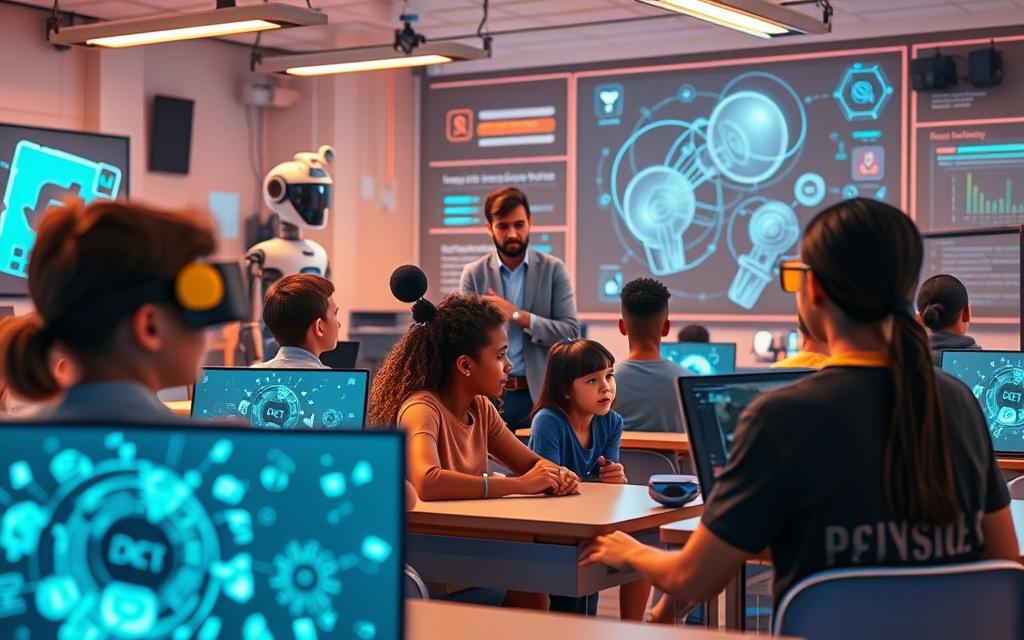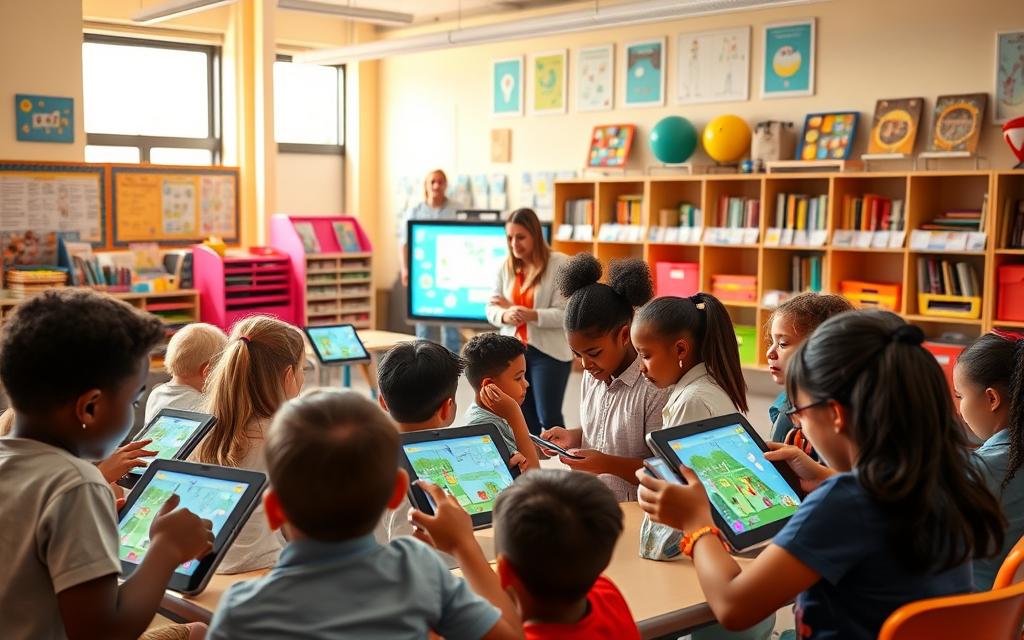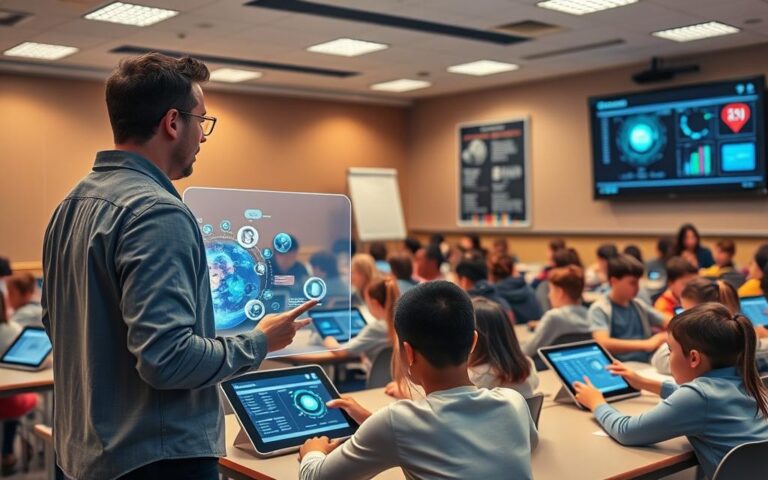Did you know that nearly 70% of students feel more involved when learning includes gamification? This surprising fact suggests a big change in education. It shows that adding game-like elements to learning really boosts students’ motivation and helps them remember more. By mixing in things like points, badges, and leaderboards, learning becomes more like a game. This makes students more interested.
Since 2003, when the word “gamification” first appeared, its use has grown a lot. This is especially true for educational games and tools used in classrooms all over the United States. Teachers looking for new ways to keep students interested find gamification very helpful. Now, learning is seen not just as a duty, but as something fun to explore.
What is Gamified Education?
Gamified education means using game mechanics for a better learning experience. It adds things like points, badges, leaderboards, and quests to learning. These make school more exciting by tapping into what makes games fun.
Definition and Key Concepts
Simply, it’s about making learning more like games. It uses game-like rules and rewards. Important ideas include:
- Points: Given for completing tasks, motivating students to take part.
- Badges: Show off what students have achieved.
- Leaderboards: Encourage friendly competition.
- Quests: Challenges related to real life, making learning practical.
Historical Background
Gamification started in businesses but moved to schools as digital tools grew. It was first for training employees. Now, it’s a popular way to make learning interactive and fun for students.
Benefits of Gamification in Learning
Gamified learning comes with big perks. About 67% of students prefer it to old-school methods. It helps in the following ways:
- Boosts involvement, so students participate more.
- Improves how well and how much students learn.
- Teaches critical thinking and solving problems with real situations.
The Rise of Gamification in U.S. Education
Gamification is becoming more popular in U.S. schools. It makes learning interactive and engaging. Stats show more schools are using these new methods.
They want to make classes more interesting. And they aim to improve how well students do in school through gamification.
Statistics on Adoption Rates
The gamification market is set to grow big. By 2025, it could be worth $1.55 billion. And it might hit $18.63 billion by 2033.
Already, over 70% of big companies use gamified strategies. Schools are starting to do this too. Soon, 87% of schools might use gamification. This shows how popular it’s becoming in education.
Case Studies of Success
L’Oréal is one company that saw benefits from gamification. It helped their employees perform better. Schools are following suit with tools like Classcraft and Kahoot.
This makes learning fun and interactive. These successful stories show gamification works in many educational areas.
Popular Gamification Tools and Platforms
Several tools have changed the way we learn, making education more fun. These platforms make classrooms interactive and engaging. They are loved by teachers everywhere.
Classcraft
Classcraft leads the way by turning learning into an adventure. It uses game elements to boost teamwork and let students see their own progress. It makes everyday lessons exciting and keeps students motivated.
Kahoot!
Kahoot! is a hit for making learning a lively competition. It lets teachers create quizzes and games easily. Students enjoy the games, making class fun for everyone.
Quizizz
Quizizz makes quizzes fun, with instant feedback and cool visuals. 85% of people say it makes students more interested. This shows how gamification can change education for the better.
Benefits of Gamified Learning for Students
Gamified learning has lots of benefits for students. It makes learning dynamic and interactive. This helps students understand things better and boosts their thinking skills.
Increased Engagement
One big advantage is that students get more involved. When lessons are like games, learning becomes more fun. Students feel more in control, compete in a good way, and connect more with what they’re learning.
Enhanced Retention of Information
Studies show that students remember more with gamified learning. They keep up to 40% more info than with traditional methods. Games make learning interactive and give instant feedback. This helps students think better and remember things longer.
Improved Problem-Solving Skills
Gamification also helps students get better at solving problems. They face real-life challenges in a game setting. This teaches them to think critically and work together to find solutions. These skills are key for success in school and later in life.
How Teachers are Implementing Gamified Education
Many teachers are using new ways to make learning more engaging. They’re bringing games into the classroom to help students get more involved. Techniques like using stories and real-life quests are now common. This helps all kinds of learners feel included.
Games are being used to teach different subjects in new ways. For example, fourth-grade teachers use games in math to make learning about complex ideas fun. They use things like leaderboards and digital badges. This makes students want to do better. Language arts classes are doing something similar, using games to help students get better at new languages.
Teachers are also combining lessons from different subjects with games. This makes learning more interesting. Students can see how different topics connect. It makes their whole educational experience better.
Challenges in Implementing Gamified Education
Gamification can really spice up learning. But it’s not always easy to bring into classrooms. There’s the problem of lacking teaching materials and the challenge of getting teachers on board. Mixing new games with old-school teaching needs work.
Resource and Training Limitations
Many schools don’t have enough money or the right tech for gamification. This makes it tough to give students a hands-on learning experience. Schools often can’t afford the tech upgrades or the software they need. Teachers might not know how to start with gamification.
They need training on how to make learning fun through games. It’s vital so they can confidently use these new methods in their teaching.
Resistance from Traditional Educators
Some teachers aren’t sure about learning through games. They wonder if it’s as good as the usual way of teaching. They worry it might not be serious enough for learning. Talking openly about how gamification helps can open their minds.
The Role of Technology in Gamified Learning
Technology is key in the world of gamified learning. With better mobile learning and immersive experiences, both teachers and students find new ways to learn and work together.
Mobile Learning Apps
Mobile learning apps have changed how we access education. They let students learn whenever and wherever. Apps like Quizizz and Duolingo help students control their learning journey.
They make it fun to practice skills and knowledge outside school. This makes learning non-stop, helping learners use their time well and understand more.
Virtual Reality in Education
Virtual reality (VR) brings new chances for learning by doing. It makes students more excited to learn by simulating real-life situations. Schools using VR see higher enthusiasm in their students.
This way of using tech changes old school methods and makes learning complex ideas fun and memorable.
Future Trends in Gamified Education
The world of gamified education is getting ready for big changes, thanks to AI and machine learning. These technologies make it possible to tailor learning for each student. This way, educators can create games that adapt as a student learns, making education more fun and effective.
The future looks bright when we think about how this will help students. Studies have found that games which make learning fun can improve grades and make students love learning more. With new tools on the horizon, students are set to enjoy even better ways to learn.

Conclusion: The Future of Learning is Gamified
Gamification in education is changing how we see traditional classrooms. It makes learning more engaging, helping students remember more and solve problems better. Schools everywhere are starting to use this approach. It turns learning into a fun activity, making the whole experience better for everyone.
The future of learning with games depends on new ideas and technologies. Teachers need to keep up with the latest ways to make learning exciting. They should work together, share what works, and use new tools. This will help keep gamified learning growing strong.
The goal is to make classrooms where learning is fun and students are happy. This will help them succeed in a world that is getting more complex every day.




